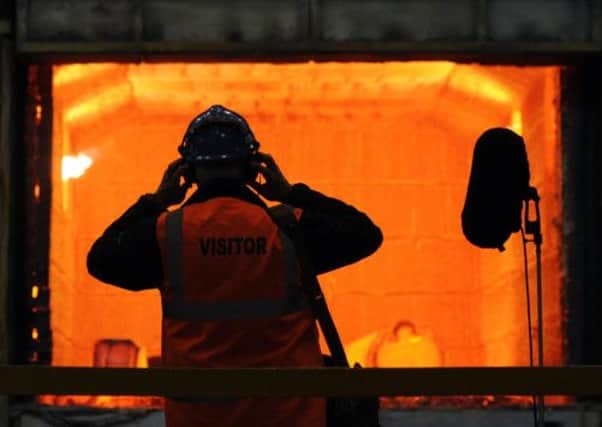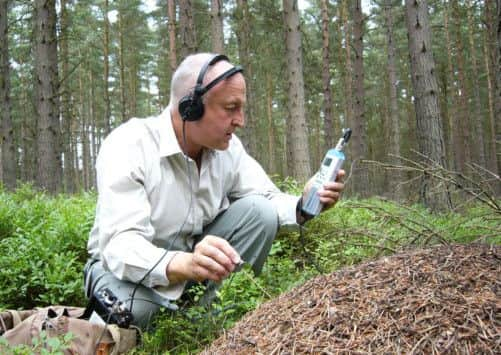From skylarks to steelworks... how the sounds of a city were put on the map


EVEN standing at a safe distance you can still feel the heat of the molten metal, which offers a sharp contrast to the inclement weather outside.
The furnaces here at Sheffield Forgemasters foundry can reach temperatures of more than 1,200 degrees Celsius, allowing engineers to forge the city’s famous steel. But these gargantuan machines aren’t only an impressive sight. You might think the crash of metal and the grinding, hissing sounds of giant ovens and pipes are nothing more than a deafening din, but you’d be mistaken. There is a rhythmic pattern to the cacophony of noise here, like metallic hymns reverberating through a cathedral of industry.
Advertisement
Hide AdAdvertisement
Hide AdThe Forgemasters site, in the Brightside area of the city, has long been part of Sheffield’s industrial landscape and it’s this rich heritage that has brought Chris Watson here. The Sheffield-born sound recordist is working on an ambitious project to “map” the sounds of his home city for a new exhibition, Inside the Circle of Fire, this autumn.


Watson, who co-founded the influential group Cabaret Voltaire back in the 1970s, hopes to transform Sheffield’s Millennium Gallery into a three-dimensional “sound map” of the city, capturing everything from its wild boundaries on the edge of the Peak District, to its modern, bustling heart.
Since leaving his pop career behind him, Watson has carved out a successful sound recording career, capturing everything from the sound of seals singing under the sea ice for David Attenborough’s Frozen Planet, to winning a Bafta for his work on The Life of Birds.
So when he was approached by the Millennium Gallery about creating a soundscape of Sheffield he was happy to oblige. Over the past 18 months he’s been busy making recordings and visiting popular landmarks such as Hillsborough and Bramall Lane, as well as inviting people to contribute their own favourite sounds to the project.
Advertisement
Hide AdAdvertisement
Hide AdFor Watson it’s meant a trip down memory lane. “I was born in Sheffield and it’s where I started recording a long time ago, so I was delighted to come back and create this sound map,” he says. “I discovered in my research something I was ignorant of as a teenager, which is that Sheffield is a city of rivers and that’s what has driven the industry and the natural landscape.”
He started his recordings in February last year at Padley Gorge in the nearby Peak District. “It was a favourite place when I was a child and it’s where I first started exploring the natural world. So I went straight back and recorded the stream tearing over the boulders and the old sandstone grinding wheels that are still up there.”
People often associate Sheffield with the sound of heavy industry but nestled next to the Peak District it is a gateway to some of the country’s most breathtaking scenery. “It’s a really beautiful place framed by this remarkable landscape, particularly the moorlands which I really enjoy working in,” he says. “I went back a few weeks ago to record the first part of the piece which was a dawn chorus over the moorland. This fantastic open, exposed landscape full of curlew, red grouse, golden plover, lapwing and skylarks.”
Watson grew up in Totley, on the border with Derbyshire, and started recording sounds when he was just 12. “I recorded sounds from my parents’ bird table in the back garden, that’s where my love and passion for sound recording in the natural world, in particular, began.”
Advertisement
Hide AdAdvertisement
Hide AdIt was while in Sheffield that he first started working creatively with sound and his sonic journey around the city has not only triggered past memories but created new ones, too. “I never managed to get over to Forgemasters when I was younger because it was at the other end of the city from me, so it’s a treat to be able to come and hear it now.”
For Watson says, sound recording is a process of investigation. “I don’t know what I’m looking for but I know it when I hear it and that’s the way I work with sound.” He’s pleased with what he’s been able to record at Forgemasters. “What I’ve heard here are some amazing textures and rhythms as well as those iconic percussive sounds which are almost orchestral.”
These sounds, he says, will have changed over the years. “Perhaps now technology is wiping that out to a certain extent, but nevertheless these kind of sounds at this end of the city, the industrial east end, are still part of the signature song of Sheffield. This is a place where the soundtrack passes through en route to the city centre, having started off in the moors and high woodlands of Blackamoor.”
The relationship between Sheffield’s industrial heritage and its rivers is a far closer one than he previously imagined. Water, he says, plays a much bigger part in the sounds of Sheffield than he previously realised. “I’m discovering something I wasn’t aware of before which is the sound and rhythm and movement of water through the city and how that’s an integral part not only of the natural landscape, but also of the fine finishing that craftsmen use.
Advertisement
Hide AdAdvertisement
Hide Ad“When you finish cutlery, which is a cold process, it uses a lot of water which is another thing I’ve discovered. So the rhythm of grinding wheels and the rhythm of water are closely entwined.”
He’s recently been down to the giant storm drain, called Megatron. “It’s underneath the Sheffield Midland railway station and it’s really interesting because I’ve been following watercourses and this is a major confluence right in the heart of the city with a large river of trains running overhead.”
One of the challenges has been capturing the sounds distinctive to Sheffield. “The problem you have with most modern cities is traffic pervades them. Whether it’s Amsterdam, Sheffield or Philadelphia, traffic noise is very similar and you have to get away from the traffic to hear the real sounds of the city.”
Which is why he spent time in the city’s pedestrianised Fargate area. “I recorded people and the local buskers because they’re part of all this. I was supposed to record the cathedral bells but it was rained off so I’d still like to do that.”
Advertisement
Hide AdAdvertisement
Hide AdAs well as recording sounds himself, Watson is also trying to make this more of a collaboration and last month he held a series of events, including sound recording workshops, to get local people involved. “The sounds of the city have changed radically and that’s why I want people to contribute to it, because I’ve not lived here for 30 years. So I’ve been asking people who do live here and experience these sounds every day to contribute recordings to the piece.”
Sheffield, of course, has a rich and varied musical heritage, but Watson says we’re perhaps all guilty of taking ordinary sounds for granted.
“One of the sad things about our lives now in the 21st century is we are bombarded by sound and noise. We ring our bank up and they play music at us, we go into a shop and it’s the same.
“So we hear everything but we rarely get the opportunity to listen and I believe listening is a creative function.”
Advertisement
Hide AdAdvertisement
Hide AdHe says the sound map, which he aims to complete by August, is about the present rather than the past. “It’s about creating something that is contemporary rather than nostalgic, so it’s the sounds of Sheffield now.”
Visitors to the gallery will be able to listen to the exhibition for free when it opens in September and Watson hopes they enjoy it. “It’s for the people of Sheffield to come and listen to the sounds of their city and perhaps listen in a new way and discover the beauty and rhythm and songs of Sheffield,” he says.
“I’d like them to come to the gallery and sit down, lie down, or just walk round and listen, and hear their city.”
Inside the Circle of Fire: A Sheffield Sound Map, runs at the Millennium Gallery, Sheffield, from September 12 this year, to February 23, 2014.
Advertisement
Hide AdAdvertisement
Hide AdFor more information on how to contribute log on to www.museums-sheffield.org.uk
Chris Watson: Sound man
Chris Watson was born in Sheffield where he attended Rowlinson School and Stannington College.
He was a founding member of the influential and experimental Sheffield band Cabaret Voltaire.
Watson’s sound recording career began in 1981 when he joined Tyne Tees Television.
Advertisement
Hide AdAdvertisement
Hide AdHis television work includes David Attenborough’s The Life of Birds programme which won a Bafta Award for Best Factual Sound in 1996.
Last year, he was the location sound recordist with David Attenborough on the BBC’s Frozen Planet series which won him another Bafta.
Inside the Circle of Fire opens at the Millennium Gallery on September 12.